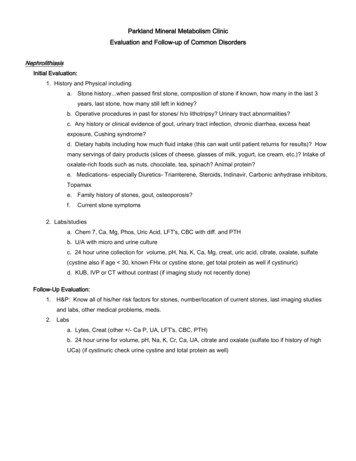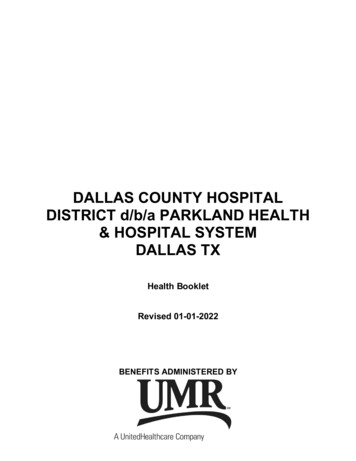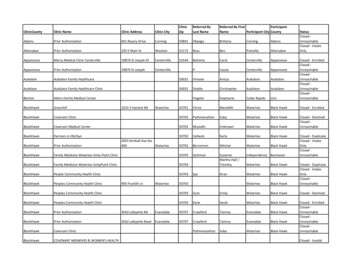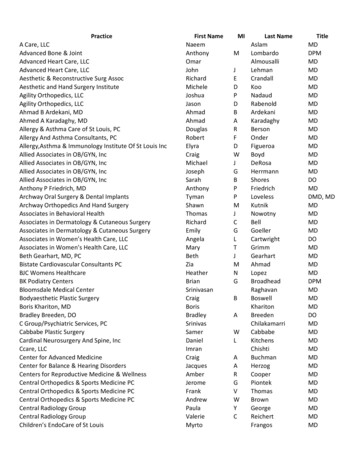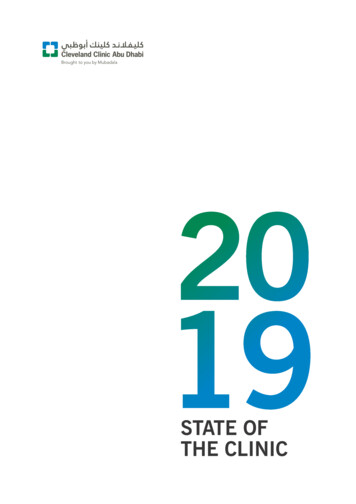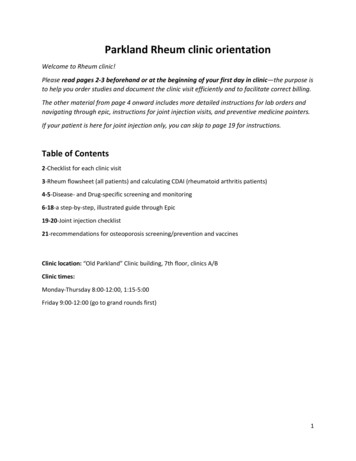
Transcription
Parkland Rheum clinic orientationWelcome to Rheum clinic!Please read pages 2- 3 beforehand or at the beginning of your first day in clinic —the purpose isto help you order studies and document the clinic visit efficiently and to facilitate correct billing.The other material from page 4 onward includes more detailed instructions for lab orders andnavigating through epic, instructions for joint injection visits, and preventive medicine pointers.If your patient is here for joint injection only, you can skip to page 19 for instructions.Table of Contents2 - Checklist for each clinic visit3 - Rheum flowsheet (all patients) and calculating CDAI (rheumatoid arthritis patients)4- 5 - Disease- and Drug- specific screening and monitoring6- 18 - a step- by- step, illustrated guide through Epic19- 20 - Joint injection checklist21 - recommendations for osteoporosis screening/prevention and vaccinesClinic location: “Old Parkland” Clinic building, 7th floor, clinics A/BClinic times:Monday- Thursday 8:00- 12:00, 1:15- 5:00Friday 9:00- 12:00 (go to grand rounds first)1
Checklist for each clinic visit (excluding visits just for joint injections):Review Past Rheum History and Past Rheum Meds from prior Rheum notes (illustrated on p. 6)Once patient’s dot turns green , turn it red , and go see the patient.Within the patient’s room , open the Visit Navigator (illustrated on p. 8)[1] “mark as reviewed” the history (illustrated on p. 8)[2] “mark as reviewed” the medication list (illustrated on p. 8)[3] Open the Rheumatology office visit smartset (illustrated on p. 9- 11)For new patients open progress note type “rheum” in the search box select “rheum new”For follow ups use one of these templates:arthritis rheumatoid arthritis, goutconnective tissue disease SLE, systemic sclerosis, MCTD, UCTD, Sjogren’sspondyloarthritis ankylosing spondylitis or arthritis associated with psoriasis,reactive arthritis, or inflammatory bowel diseaseOther anything else including inflammatory myositis or vasculitis*The templates guide you through pertinent review of systems and exam[4] all patients “rheum flowsheet” (illustrated on p. 3 and 12)[5] rheumatoid arthritis patients CDAI (illustrated on p. 3)[6] discuss patient with attending[7] order/renew prescriptions- see pages 4- 5 for recommended disease- specific and drug- specific monitoring- see page 5 for pregnancy/lactation- related medication pointers[8] order labs using standing orders (illustrated on p. 13- 15)[9] place orders for imaging, referrals, and vaccines[10] within “LOS and follow up” specify the return to clinic time and type patient instructions,including detailed instructions on when to get labs (illustrated on p. 17- 19).[11] turn patient’s dot YELLOW so the nurse will check them out[12] Complete your progress note using the F2/left click/right click feature- within history section, indicate that you have reviewed one of the past medical, surgical,family, or social histories for follow ups , or all four of the histories for new patients- review of systems for new patients must have 10 systems with at least one comment- Before signing , click on the refresh button so your rheum flowsheet info will be imported2
Rheum flowsheet: facilitates assessment of patient’s progress from visit to visitInstructions: Each patient should have received a sheet of paper with HAQ questionnaire, patient global assessment,and pain score . Within the “Rheum flowsheet” in epic, make sure that the nurse has populated each of these scoresfor this clinic visit. If not, populate the scores yourself. If the patient did not receive the sheet beforehand, populatethe scores yourself by asking the patient each question shown in the flowsheet.Additionally, for Rheumatoid Arthritis patients , fill in the provider global assessment, tender and swollen jointcounts, and CDAI score as instructed below.Import this info into your progress note by clicking on the refresh button within the progress note.Tender/swollen joint count and CDAI (clinical disease activity index)Palpate each of the joints shown in black (28 total, 14 on each side). Count the number that are swollen (youropinion) and tender to palpation (their opinion)Patient global assessment score is patient’s assessment of their RA activity (1 is low, 10 is high)Provider global assessment score is physician’s assessment of patient’s RA activity (1 is low, 10 is high)Add the swollen joint count (1 for each joint), tender joint count (1 for each joint), patient’s global assessment, yourglobal assessment. The total is the CDAI, which is interpreted as follows:Disease ActivityRangeRemissionLowModerateHigh0- 76 2.8 2.8 - 10.0 10.0 - 22.0 22.03
Disease- and Drug- specific screening and monitoring(1) Inflammatory arthritis (rheumatoid arthritis or spondyloarthritis)Every 3 months, check “standard labs” - - cbc, AST and ALT, BUN and Cr, ESR and/or CRP.Also follow the drug- specific instructions below:Medicationnon- biologic DMARD*methotrexate, leflunomide,sulfasalazinePre- screeningHeavy alcohol use , “standardlabs,” HCV Ab, HBV sAg, coreIgM, core total, and surfaceAb, and chest x- rayTNF poniAbatacept (Orencia)Rituximab (Rituxan)Tocilizumab (Actemra)same as above, and also askabout history of CHF, and sendquantiferon gold or T- spotHydroxychloroquine (plaquenil)Same as TNF inhibitorSame as TNF inhibitorSame as TNF inhibitor, and alsocheck lipid panel“standard labs,” and G6PDMonitoring“standard labs”— 1 monthafter starting med orincreasing the dose , thenevery 3 months on a stabledoseQ3month “standard labs”Q3month “standard labs”Q3month “standard labs”Q3month “standard labs”Fundoscopic exam yearly*Whenever methotrexate is prescribed, folic acid 1 mg daily should also be prescribed4
(2) Systemic lupus erythematosus“standard labs”- - cbc, AST and ALT, BUN and Cr, ESR—check these every 3 months“Lupus nephritis labs”— C3, C4, dsDNA, UA, urine protein, urine creatinine- every 6 months if no history of lupus nephritis- every 3 months if history of lupus nephritis in remission- every 1 month if active lupus nephritis***if active lupus nephritis, patients should be followed by renal clinic too***Also follow drug- specific instructions nil)Azathioprine (Imuran)Mycophenolate mofetil(Cellcept)Belimumab (Benlysta)Cyclophosphamide (Cytoxan)Pre- screening“standard labs,” and G6PDMonitoringFundoscopic exam yearly“standard labs,” and TPMT ,and allopurinol use (cannotuse azathioprine concurrentlywith allopurinol)“standard labs”Q3month “standard labs”“standard labs”“standard labs”Q3month “standard labs”Q3month “standard labs”Q3month “standard labs”(3) GoutAt all clinic visits , check “standard labs,” CRP, and uric acid. No additional drug- specific labs, but askattending if labs need to be checked between current clinic visit and next one (e.g., at 3 monthintervals).(4) Other (systemic sclerosis, MCTD, UCTD, Sjogren’s Disease, inflammatory myositis, vasculitis)case- by- case basis—discuss with attending during check- outPregnancy and lactation:If your patient is a woman of childbearing age and is taking one of these medications, tell her that themedication is unsafe to take during pregnancy and discuss with her her method of birth control:- methotrexate, leflunomide (Arava), cyclophosphamide (Cytoxan), mycophenolate mofetil (cellcept),or rituximab (rituxan)Additionally, methotrexate and cyclophosphamide have effects on sperm cells in men. It isrecommended that these medications be stopped for 3 months before a man fathers a child .5
Parkland rheum clinic Epic guide[ ] Open Epic in “Rheumatology” login context “schedule” “Rheumatology, Resident”[ ] Once a time appears by the patient’s name, you can open their chart and start looking them up.[ ] pay special attention to the history of rheumatic disease and update it in your note if you havetime—would like to have the year of diagnosis, disease manifestations at time of diagnosis e.g.,“morning stiffness, hand arthritis, RF and CCP”, and brief summary of disease course , e.g., “RAwas poorly controlled on methotrexate but has been well- controlled on methotrexate Enbrel.”[ ] pay special attention to the Past rheum meds and update it in your note if you have time— years ofuse , e.g., “methotrexate from 2012- 2013,” reason for stopping , e.g., “stopped due to poor efficacy”vs. “stopped due to rise in liver enzymes.”6
7
Within “visit navigator”[ ] review the medical, surgical, family, social history—click “mark as reviewed”[ ] review the medication list —click “mark as reviewed”Visit Navigator (VN)Mark as Reviewed(1) Medications(2) Past Medical/Surgical/Family/Social History8
[ ] open the rheumatology office visit smartset9
10
[ ] for follow up patients select one of the four clinic note templates and open the note by clicking“Edit” or “pend.” If you “pend” then you can re- open the note under the “notes” tab on the left.11
[ ] Fill in the ROS, History, and Exam sections using the F2/left click/right click feature[ ] Go to the “Rheum Flowsheet” within the visit navigator . Make sure the nurse has populated theHAQ, patient global assessment, and pain scores. If not, then update the scores yourself now. Thepatient is supposed to have filled out a piece of paper already with these scores. If this was notdone, (1) ask the patient the questions and fill in the scores as you go, and (2) notify Dr. ElizabethSolow after clinic about a patient not getting the survey prior to being roomed (so she can remind thenursing staff to do the surveys)[ ] If patient has rheumatoid arthritis, complete the disease activity scores by adding thetender/swollen joint count (see page 3 for instructions), provider global assessment, and total CDAIscore. For any other disease, this step is omitted.[ ] within your note, click on the green refresh button so your flowsheet info will be imported[ ] discuss patient with attending. (Attendings should be entering the visit diagnoses during yourpresentation. If they are not doing this mention it to them) . Then go see patient with attending ( cankeep working on note or putting in orders in the patient’s room while attending examines patient )[ ] renew prescriptions (for DMARDs , prescribe only a 3- month supply , unless instructed otherwise)[ ] if your prescription is non- formulary, fill out a non- formulary request, get the attending’s signature,and walk the request to Elizabeth Moss’s office adjacent to PCIM clinic. You will know that themedication is non- formulary if it does not show up under “facility list” when you are ordering it.[ ] Find the recommended labs and monitoring on pages 4- 5 based on which disease and prescriptionsyour patient has. Also check page 5 regarding medications unsafe in pregnancy.[ ] If methotrexate is prescribed, folic acid 1 mg daily should also be prescribed12
[ ] order future labs. Use the standing orders located in the smartset .Note: may choose to unclick the ones you don’t need, e.g., AST and ALT vs full set of LFTs13
[ ] If additional labs need to be ordered, order them under the “order entry” tab on the left side of thescreen. Order them as standing orders (see below for instructions).14
15
[ ] order imaging and referrals as needed. Some commonly used imaging and referrals are alsoavailable in the smartset. If not, then type them in under “order entry.”16
[ ] Within “LOS and follow up” type “no charge,” type the name of the attending, indicate the time toreturn to clinic, and type the patient instructions.- write instructions for patient understanding a the 4th grade level- patient’s nurse will copy/paste this over to the patient’s discharge instructions and re- review[ ] Include instructions on over- the- counter meds (for example calcium and vitamin D).[ ] If patient needs labs today, type “labs today” in the patient instructions. If patient needs labs later(for example in 4 weeks or 3 months), type “labs in 4 weeks” or “labs in 3 months” in the patientinstructions. The nurse or clinic coordinating staff will follow your instructions to link your lab ordersto a lab appointment .[ ] Once you’ve typed the patient instructions, you can copy them and paste them into your note tosave you time writing the note.17
18
Joint injection checklist[ ] read the most recent rheum clinic note to confirm the joint that is to be injected.[ ] Pay special attention to whether arthrocentesis is needed too. This will be an additionalconsent, and you might need to order labs beforehand[ ] Go to patient’s room and confirm with them that they want the procedure[ ] while in the patient’s room, re- open the patient’s chart in epic[ ] select “iMed” on the left (just above “visit navigator”)[ ] Under “Browse,” scroll down, then click “Rheumatology” “Consents- Basic”[ ] Select “Joint – Injection of Corticosteroid”[ ] if considering arthrocentesis as well, type “Aspiration of Joint or Periarticular structure”[ ] At the bottom right of the screen, check “Start”[ ] Under “Input,” fill in each section of the consent that has a red asterisk[ ] Once you have explained the procedure, obtain the signature of patient, yourself, and a nurse.This is done using the mouse or with the electronic pad and pen.[ ] When you’re finished, select “Generate Document” at the bottom right of the screen then savethe document.[ ] Leave the patient’s room and go back to the workstation and confirm with attending whatprocedure is planned[ ] once discussed, order the following drugs using the “Order Entry” tab, unless directed otherwise byattending:[ ] type “ triamcinolone ” select “database lookup” in the top right, then select Code 9701 ,“Triamcinolone acetonide 40 mg/ml Intramusc 40 mg" double click it Dispense 1 vial, 0refills[ ] type “ lidocaine ” select “database lookup” in the top right, then select Code 143608“Lidocaine (PF) 10 mg/ml (1%) injection” dose 1 ml Dispense 1 vial, 0 refills[ ] if you are performing arthrocentesis , order labs now using the “order entry” tab—discuss withattending which labs. Here are some common examples:[ ] Lab202201 “Body fluid cell count with differential” “clinic collect” “routine” Specimen Source “Joint”[ ] Lab202057 “Joint fluid crystals” “clinic collect” “routine”[ ] ask a nurse to gather the two drugs and the following supplies:[ ] needles (ask attending what gauge, size, and how many)19
[ ] syringes (ask attending what size and how many)[ ] 1 packet of iodine swabs[ ] 1 alcohol swab[ ] ultrasound if your attending wants to use it[ ] band- aidAnd if doing arthrocentesis , also ask nurse for[ ] stickers for the labs[ ] extra 10 or 50 cc syringe depending on how much fluid is in the joint[ ] cap for syringe[ ] bio- hazard bag to put the capped syringe in afterwards[ ] if you’re getting labs, write the following on each lab sticker: initials, date, time, and “joint fluid”[ ] once you have all the supplies and the drugs, tell the attending you’re ready and go back to thepatient’s room[ ] do the procedure[ ] if there are labs, ask your nurse to send them to the lab[ ] Under the “LOS and follow up,” type patient instructions, e.g.: “Avoid heavy use of the injectedjoint for the next couple of days. Notify the clinic or go to the emergency room if you have fevers,chills, or if the joint becomes more swollen or red or painful.”[ ] turn patient’s dot YELLOW so they can be checked out[ ] write a brief progress note that says“Patient presented to clinic today for arthrocentesis (if applicable) and steroid injection of [whicheverjoint you did]. See procedure note for details of the procedure.”[ ] to write a procedure note, go to “Notes” tab select “Create Note in NoteWriter” under“select a note type,” type “procedure” “accept”[ ] put your attending as the “authorizing provider”[ ] Arthrocentesis is one of the tabs at the top—if you did this then select this template fill in thetemplate sign your note[ ] if you did joint injection, then select the tab that says “more” then select “Injection” fill in thetemplate sign your note20
Osteoporosis screening and prevention:Consider ordering a screening DEXA for patients age 50 and older with risk factors (steroids, alcohol,smoking, parental history of fracture):Consider calcium and vitamin D supplementation of each clinic patient:Most calcium and vitamin D preparations are not on formulary but can be purchased over thecounter at any pharmacy. Be sure to include specific instructions for this in the patient instructionssection.Typical calcium dose: 1,000 mg daily (calcium carbonate, or calcium citrate if they are on a PPI )Typical vitamin D dose: 2,000 units of cholecalciferol daily**alternative is check the 25- OH vitamin D level. If 20, prescribe ergocalciferol 50,000U weekly for 8weeks. This is on formulary .Vaccines:- flu shot once yearly (to get the flu shot done, simply write “give flu vaccine today” as the top line inyour patient instructions. You do not need to place an order for flu vaccine)- pneumovax for all patients 65 or older (pneumovax must be ordered within the “order entry”)- pneumovax for patients of any age with any of the following:- disease associated with impaired immunity (RA, SLE)- immunosuppression (including prednisone)- smoking- chronic heart, lung, liver, or renal disease- 2nd pneumovax when(a) patient is 65 or older, and(b) 1st pneumovax was before age 65, and(c) was 5 or more years ago21
Parkland rheum clinic Epic guide [ ] Open Epic in "Rheumatology" login context "schedule" "Rheumatology, Resident" [ ] Once a time appears by the patient's name, you can open their chart and start looking them up. [ ] pay special attention to the history of rheumatic disease and update it in your note if you have


